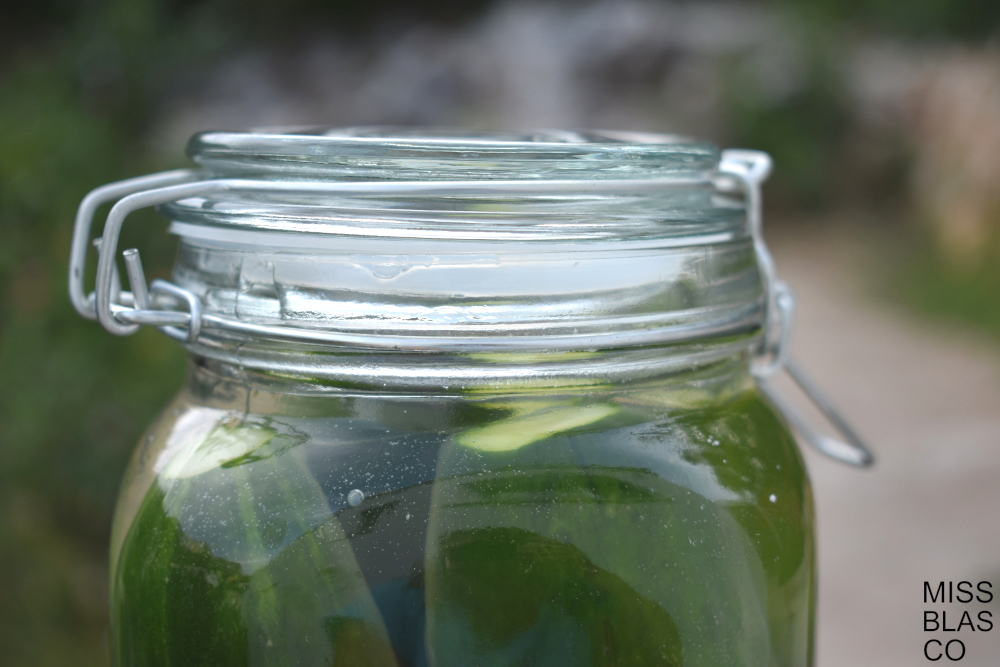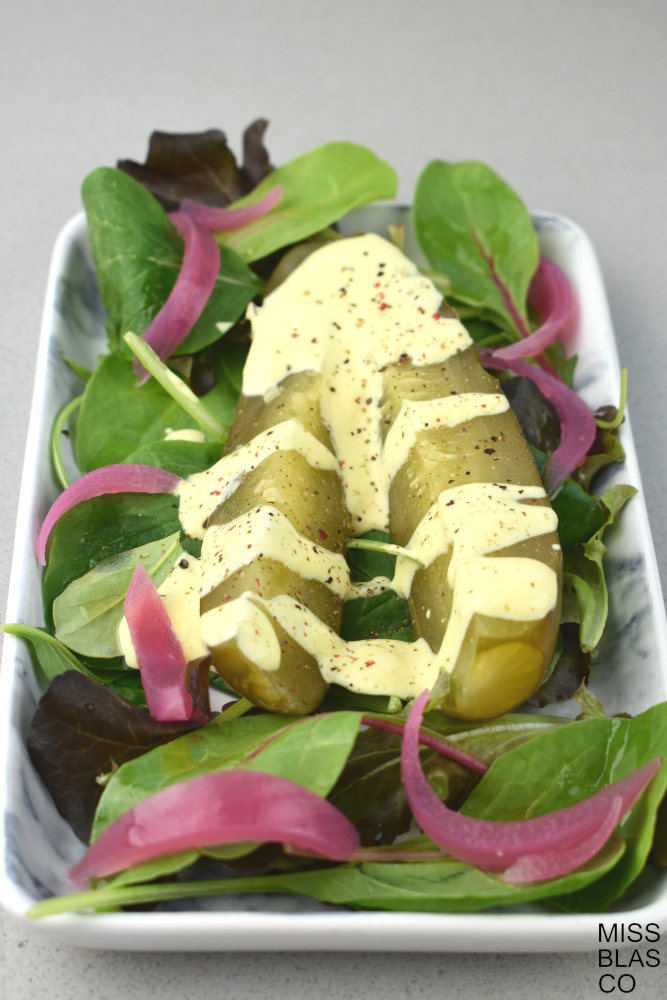
HOW TO FERMENT CUCUMBERS
Fermenting cucumbers is very easy, like any vegetable, it’s about preparing a brine and keeping them submerged in it for a few days.
You can flavor them with herbs, add peppercorns, a few cloves of garlic, whatever you like. To start, I recommend fermenting the vegetables separately and seeing what flavors they acquire and the resulting texture. With all the vegetables already fermented you can make combinations, delicious salads, mixing them with fresh vegetables, with pickles and dressing them with homemade sauces based on olive oil, yogurt, mustard, etc. Fermented vegetables are especially delicious as a side dish, what do you say about a Brackwurst with sauerkraut and fermented cucumbers, with mustard sauce and some fresh arugula leaves? It is just an example of what you can do with fermented vegetables, I love them in salads, and mixed with sprouted legumes, for example, sprouted red lentils with fermented onion and carrot, on a base of green leaves, with a good vinaigrette of olive oil and lemon fermented.
Fermenting cucumbers and other vegetables is easy and very cheap.
Yes, lemons are also fermented and are delicious. They keep for many months in the refrigerator and you can use them little by little. Since I started making them, I use them a lot.
How to use fermented lemons? To start with, I’ll give you three ideas: in hummus, in baba ganoush, and in any dressing or vinaigrette. But there are more options. I’ll tell you about them in this post.

Returning to cucumbers, I will tell you that they are one of the vegetables that ferment the fastest, especially in summer, if the room temperature exceeds 23-24ºC, between 5 and 10 days will be more than enough, if it is higher, see how they are after 5 days, surely you can consume them.
The first day, when you containerize them and cover them with the brine, the water will be clear, the next morning after 8-12 hours, there will already be many bubbles rising from the bottom of the jar to the surface, it is a very good sign, the process has begun.
On the second day the water will have already become cloudy and from then on, it will be a little whiter every day, don’t worry, it is the bacteria and yeast that are growing, this indicates that the fermentation is going very well.
Remember that temperature and time are two fundamental factors, the higher the temperature, the less time you will need, the fermentation will occur more quickly, however at low temperatures, the fermentation slows down and you will need more time to obtain the desired result.
What do I need to prepare my fermented cucumbers?
As I have mentioned before, there are few things, the most important being a little patience, you also need preferably organic cucumbers, filtered water, sea salt and a very clean glass jar.
To make these fermented cucumbers there is a fundamental ingredient, patience.
Wash the cucumbers, remove the ends and make longitudinal cuts, leave the four parts joined at one end, do not remove the skin, it will provide more microorganisms to the fermentation.

Prepare the brine, for these cucumbers I made a 2% brine, this means that for every liter of water I added 20 g of sea salt, it is important to dissolve the salt well in the water before adding it to the jar.
Place the cucumbers in the jar, put them vertically, try to fill all the space with them, if they fit well enough, better, they will have less tendency to float.
Now you can add peppercorns, herbs like dill, cloves, coriander seeds, cumin seeds, whatever you like best. I usually ferment them as is, without adding anything, or just a few black peppercorns.
Add the brine, cover the cucumbers completely.
If the cucumbers are packed tightly in the jar, they won’t float, but if you can’t get them that tight, make sure to put a weight on them to keep them from rising out of the liquid.
You can put half a lemon, a piece of carrot fitted to the mouth of the jar as a “beam”, or a glass container (a vsmall asito), filled with brine.

Cover the jar, if it is one of those that close hermetically, you will have to open it from time to time so that the CO2 that will be generated escapes.
You should store the jar in a cool, dry and dark place, make sure that it is not exposed to light direct.
Improve your digestive health by preparing vegetable ferments, a very natural way to take care of yourself.
In summer, at a temperature above 20-22ºC, you will have them ready in 5 days, if it is winter, at a temperature of 18º or lower, you will have to leave them longer, in any case I advise you to try them, it is your decision to stop the fermentation depending on the flavor, the acidity level, etc.
As you can see in the image, one way to consume them is in a salad, accompanied by other fermented foods, in this case red onion, with some green leaves and a mustard-based sauce.
They are an excellent garnish for smoked meats, I also really like them to accompany oily fish, or some delicious, good quality German sausages.
If you are vegetarian you can combine them with legumes, sprouted or not, with sprouts, with rice, the combinations are many, when you try them you will notice that fresh, vinegary and acidic flavor, and decide what to combine them with.
To dress them you can opt for extra virgin olive oil or prepare a dressing, what goes best with them is mustard, you can add Dijon mustard, or make a lighter sauce with yogurt, lemon, and spices.
Why I like these fermented cucumbers so much:
- Their preparation requires little effort and little time, it is a very simple process.
- The result is surprising.
- I like them as garnish.
- Any fermented food, even if it is short fermentation, provides live microorganisms to our microbiota and enriches it.

If this idea sounds appealing to you, try preparing them at home, and then tell me about it. Improve your diet and your digestive health with these preparations, I recommend it. Health! 😉
Bibliography:
- Pure fermentation. Sandor Ellix Katz.
Related posts:
- Learn how to ferment cabbage at home (sauerkraut).
- How to make easy kimchi.
- How to ferment vegetables in house.

CÓMO FERMENTAR PEPINOS
Ingredients
- 400 g pepinos medianos (4 unidades)
- 1 l agua filtrada
- 20 g sal marina
- especias variadas (opcional)
Instructions
- Lava los pepinos, quítales los extremos y hazles unos cortes longitudinales, deja las cuatro partes unidas en uno de los extremos, no les quites la piel.

- Prepara la salmuera, para estos pepinos yo hice una salmuera al 2%, esto quiere decir que por cada litro de agua puse 20 g de sal marina. Es importante disolver bien la sal en el agua antes de añadirla al bote, puedes templar el agua para que sea más fácil.
- Coloca los pepinos dentro del bote, ponlos en vertical, trata de ocupar todo el espacio con ellos, si quedan bien ajustados mejor, tendrán menos tendencia a flotar.
- Añade la salmuera, cubre los pepinos por completo. Si los pepinos quedan prietos en el bote, no flotarán, pero si no consigues ajustarlos tanto, deberás asegurarte de poner un peso sobre ellos para que no salgan del líquido.
- Tapa el bote, si es de los que cierran herméticamente, tendrás que abrirlo cada cierto tiempo para que salga el CO2 que se irá generando.

- Deja el bote en un lugar fresco, seco y oscuro.
- Si la temperatura supera los 22-23ºC, en 5 días estarán listos, si es más baja puedes dejarlos más tiempo, hasta 15 días, pero te aconsejo que los vayas probando y que los consumas cuando consideres que más te gustan.
- Consúmelos en ensalada, como guarnición, con mostaza, con AOVE, con vinagreta, es tu decisión.

Amarilis
Gracias por esta receta. He estadouy necesitada de ella y la descubri hoy, no creo en la casualidad jjj es q realmente será muy beneficiosa a mi salud.
Llevo un buen tiempo con afecciones en la piel y con tratamiento casero para eliminar la candida xq vivo en Cuba y no tengo opcion de medicamentos farmaceuticos, uso mucho las hierbas y remedios naturales.
Estaba buscando como fortalecer mi sistema inmune y revitalizar la flora intestinal.
Gracias a un video q acabo de ver en Google de Bienestar inginito q m instruyo sobre el tema
missblasco
Hola Amarilis,
muchas gracias por tu mensaje. Me produce mucha tristeza la situación que se está viviendo en Cuba, ojalá se acabe pronto y tengáis acceso a todo lo que como ciudadanos merecéis.
En cuanto a la cándida, se trata de un desequilibrio en la microbiota, está demostrado que la mejor manera de combatir este tipo de disbiosis es con el consumo de fermentos y cambios en el estilo de vida. Los fermentos recomendados son los que se hacen con sal, como estos pepinos, pero también puedes fermentar rábanos, zanahorias, cebollas. Muy interesante el consumo de chucrut y kimchi. Por supuesto es muy importante eliminar el azúcar de la dieta y las harinas refinadas, y también es fundamental hacer ejercicio y moverse mucho.
Espero que te mejores y que todo vaya bien.
Un cordial saludo.
Francesca. 😉
Maria
Hola! Que buena receta. Tengo una pregunta: ¿Puedo cortar los pepinos en rodajas o de alguna otra manera si no tengo un bote tan alto?
Gracias!
missblasco
Hola Maria, efectivamente, puedes cortar los pepinos, pero en ese caso debes reducir el tiempo de fermentación. Si el pepino está cortado, la piel ya no actuará como protección y se fermentará más rápido. Vigila el proceso con atención.
Gracias por tu consulta, saludos!
Fgracia
Muchas gracias por la Receta. Creo que La ensaladilla tradicional de Espana con el piccadillo de vegetales como los pepinillos y las zanahorias es mas saludable con los vegetales en salmuera que en vinagre
Si se quieres conservar durante mucho tiempo como se puede sellar el bote de cristal?
missblasco
Hola, si los pepinos están en vinagre se puede hacer el procedimiento tradicional de conserva, pero si se trata de pepinos fermentados, lo ideal es consumirlos poco a poco guardándolos en la nevera, de esa forma paras el proceso de fermentación y duran mucho.
No sé si te he aclaro la duda.
Gracias por comentar! 😉
Sylvia Harroch
Thank you for all the info. I have a question: I have followed all the instructions but my cukes never obtain the sour smell that tells me they have fermented properly. Most of the time they smell musty or bad. What am I doing wrong? I heard that you should blanch the cukes before fermenting. Is that the right thing to do?
Thanks for your help,
Sylvia
missblasco
Hi Sylvia, properly fermentation depends on several factors, one of the most important is room temperature, if it’s hot fermentation time decreases, if it’s cold, fermentation time must be longer. Cucumbers are fermented in a few time, so check that requeriment because it’s critical.
To blanch the cucumbers is not necessary, to wash it well should be enough.
Clean glass jars, dark storage and the right period of time is all you need to ensure a good result.
Many thanks for your question.
Dante Linares
Hola desde Perú.
Una pregunta, si el pepino es demasiado largo para el envase, puedo ponerlo en mitades?, de ser así, las partes con cortes hacia donde deben apuntar,. hacia el fondo o hacia la boca del envase?
missblasco
Hola Dante, en primer lugar me disculpo por la tardanza en responder.
En cuanto a los pepinos puedo decirte que sí se pueden cortar y que es indiferente ponerlos en una dirección u otra, aunque yo los pondría mirando hacia abajo siempre.
Saludos.